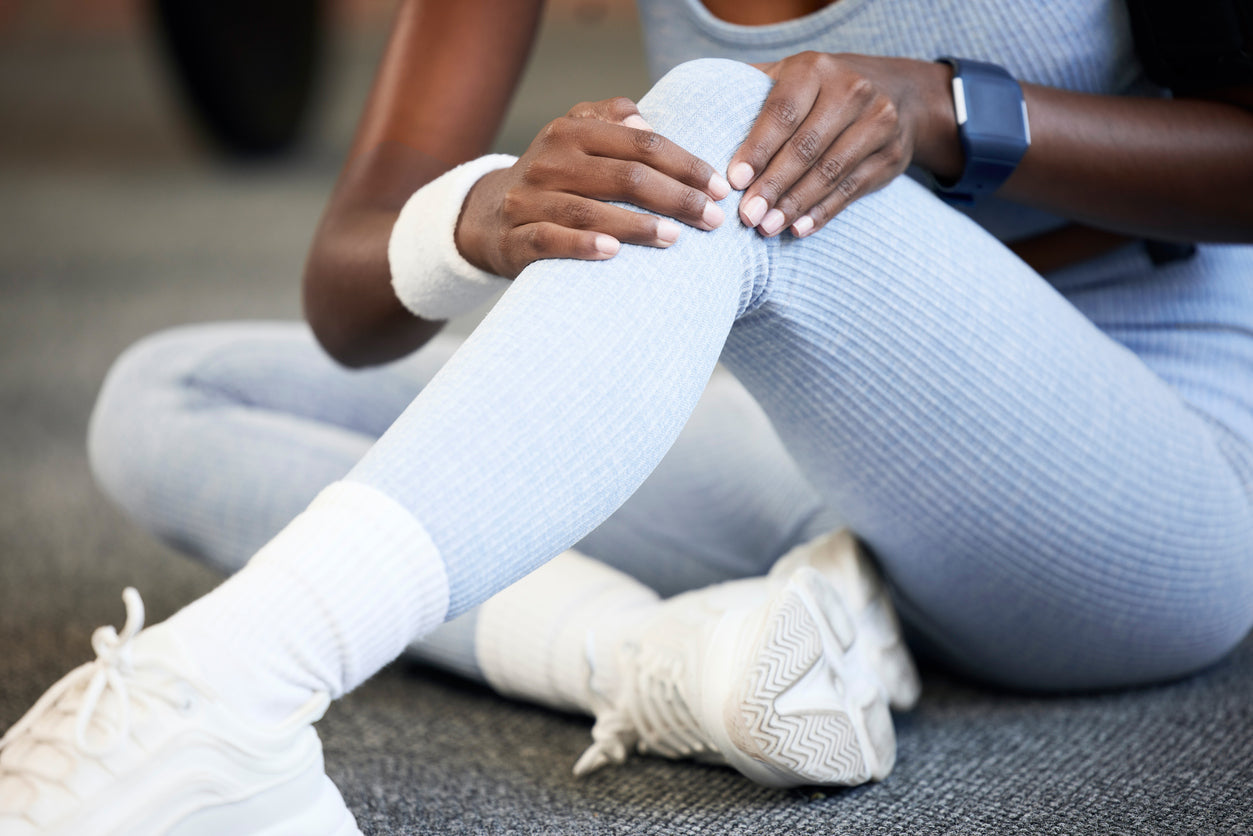Whether you are a fitness fanatic, a regular gym go-er or low on mobility, knees are always a common problem that personal trainers occur in and outside of the gym. Bad knees can be caused by any number of issues so knowing how to prevent further injury and strengthen your knees will be beneficial for a multitude of reasons! Today we have spoken to physiotherapist, Paul Cremin from Pulse Physio to ask him all about knee strengthening exercises. Everything from specific physio exercises for knees, knee mobility exercises, exercises for stiff knees and inner knee pain exercises.
Why might I need to start doing knee strengthening exercises?
You might need to start doing knee strengthening exercises for various reasons, such as preventing injury, improving mobility, or managing existing knee pain or discomfort. Strengthening the muscles around the knee, including the quadriceps, hamstrings, and calves, can help provide better support and stability to the joint. This is particularly important if you engage in physical activities that put stress on the knees, such as running, jumping, or playing sports. Additionally, as we age, maintaining strong knee muscles can help reduce the risk of conditions like osteoarthritis and improve overall quality of life by ensuring better movement and functionality. If you're a personal trainer looking to expand your knowledge in injury prevention and recovery, the National Register of Personal Trainers (NRPT) has plenty of helpful resources.
We have a great blog on ‘Knee Strengthening Exercises for Running’ so if you are into running make sure to check it out.
What are the benefits of knee exercises?
Knee rehab exercises are designed to strengthen your knees and regain a range of motion in the knee - not just the muscles, but the ligaments and joints themselves. Doing regular knee exercises can reduce the rate of joint degeneration and prevent the development of joint problems mentioned above. There are a multitude of benefits including: increased strength, improved flexibility and range of motion, injury prevention, pain relief, enhanced functionality and the management of chronic conditions.
For trainers looking to improve their knowledge on exercise programming and rehab, Premier Global offers great courses to help you level up.
What are some examples of general physio exercises for knee pain?
Physiotherapists are often the best people to ask for specific knee exercises. This is usually because general exercises are not sufficient to help an injury recover, having specific physio exercises for knee pain or discomfort tailored to you and your specific injury will help you recover quicker. It is important to remember that the knee is supported by a number of different muscles, each with their own role to play. We target specific deficits in muscle activation and work on that - an example would be exercises targeting the inner quadriceps (VMO muscle).
Can I do knee strengthening exercises at home?
Yes, you can. In physiotherapy it is preferable to make exercises both meaningful and functional. A great example of knee strengthening exercises at home would be simple step ups and rising from a chair. These are activities your knees must go through regularly so is something that can be a core focus for overall strength and function at home (and done anywhere!)
Check out our blog on Functional Strength Training to see how you can build in exercises to help you perform activities in everyday life.
In terms of training at home you can use weights to put a little pressure on your knee when it feels comfortable. The best thing to do is start light with a low weight/resistance paired with a higher amount of repetitions as this will help to build progression over time. Try to avoid going to your maximum capacity at the start, aim for between 50-60% initially and progress as you become more accustomed to knee exercises, so you don’t strain or cause any immediate issues.
If you are looking for some inspiration, then discover our blog on Resistance Training Exercises here.
Different types of knee exercises:
Can you give some examples of exercises for knee injuries?
Exercises for knee injuries typically focus on strengthening the muscles around the knee while minimizing stress on the joint. Examples include straight leg raises, hamstring curls, quad sets, mini squats, step-ups, and wall sits. These exercises help improve knee stability and support, aiding in recovery from injuries such as ligament strains, meniscus tears, or patellar tendinopathy.
Can you give some examples of exercises for bad knees?
Bad knees are often helped by gentle stretching to improve mobility and everyday functional exercises such as sit to stand from a chair. Individuals with bad knees often benefit from low-impact exercises that strengthen the surrounding muscles without exacerbating pain or discomfort. Suitable exercises for bad knees include swimming, cycling, water aerobics, yoga (with modifications), tai chi, and using elliptical machines. These activities help improve knee function and mobility while reducing stress on the joints.
Can you give some examples of exercises for sore knees?
Exercises for sore knees need to be planned with care as it is important that they do not make the soreness increase. K nee pain exercises can include gentle stretching and strengthening exercises which can help alleviate discomfort and promote healing. Examples include seated knee extensions, calf stretches, hamstring stretches, gentle quadriceps strengthening exercises, and low-impact aerobic activities like walking or stationary cycling. These exercises can help relieve tension and improve flexibility in the muscles surrounding the knee joint.
Can you give some examples for inner knee pain exercises?
Inner knee pain may stem from t he vastus medialis oblique muscle which supports the inner knee. This is the part of the quadriceps (front thigh muscles) on the inner knee area. This muscle can be targeted with knee extension (straightening) exercises with your hip rotated out to the side. Inner knee pain exercises need the inner knee area to be facing up so the knee has to work harder against gravity, working the muscle and overall alleviating any discomfort.
Can you give some examples of exercises for stiff knees?
Stiffness in the knees can be improved with gentle stretching and mobility exercises. Examples of exercises for stiff knees include; knee flexion and extension stretch, heel slides, seated knee bends, and leg swings. Stretching is also more effective the longer you hold the stretch (within reason), we would suggest stretching and holding for between 1-2 minutes in each stretch depending on your ability to do so. This is much more difficult if you are forceful, so make sure to take it easy! We would suggest doing this 3 times a day for the most affective results (and more if you’re able to!)
Can you give some examples for knee mobility exercises?
To help your knee bend, sometimes it is convenient to stretch whilst sitting in a chair. Bend your knee back as far as you comfortably can, then use the other leg to gently nudge the stretch a bit more and hold. Knee mobility exercises can cause a mild discomfort which is acceptable, however if this turns to pain then make sure to rest and back off a little to be able to progress. Stretching should be daily when joints are genuinely stiff, as mobility improves and you are maintaining mobility, this can be dropped to as little as 1-2 times per week.
How many times per week would you suggest to complete knee strengthening exercises?
This will vary depending on your level of activity. Those who are unaccustomed to exercise may need to exercise much more frequently, but with much less intensity and duration. Little and often is helpful for this type of person, particularly with degenerative joint diseases i.e. a few minutes every 1-2 hours during the daytime. For those who are accustomed to exercise, it can be very intense, approaching, or at, maximum capacity, 3-4 x week. Painful knees are rarely able to cope with this and physiotherapists start light and gradually increase the quantity.
A summary of the best knee strengthening exercises
To wrap up, Paul has covered all elements of the best knee strengthening exercises including why it’s important to strengthen your knees and muscles surrounding your knees for preventing injury, improving mobility and managing any pain or discomfort. He has also given us a wide variety of specific exercises to try including exercises for bad knees, exercises for knee injuries and exercises for sore knees, plus many, many more! We have learnt you can also easily complete knee strengthening exercises at home with basic knee mobility movements including standing from seated position and stepping up – something each and every one of us can try to practice! It is important to remember that Paul does always suggest seeing a physiotherapist for fast improvement who can give you exercises specifically tailored for your injury. If you or a client are suffering from bad knees, then we hope you have found this Q&A helpful and you can soon see some improvement.
Want to dig a bit deeper and help others too? Check out our PT & Gym courses with qualifications in nutrition, mental health and specialist areas we have something for everyone looking to start their PT journey!
Article by Paul Cremin, Physiotherapist from Pulse Physio and edited by Jemma Walsh







